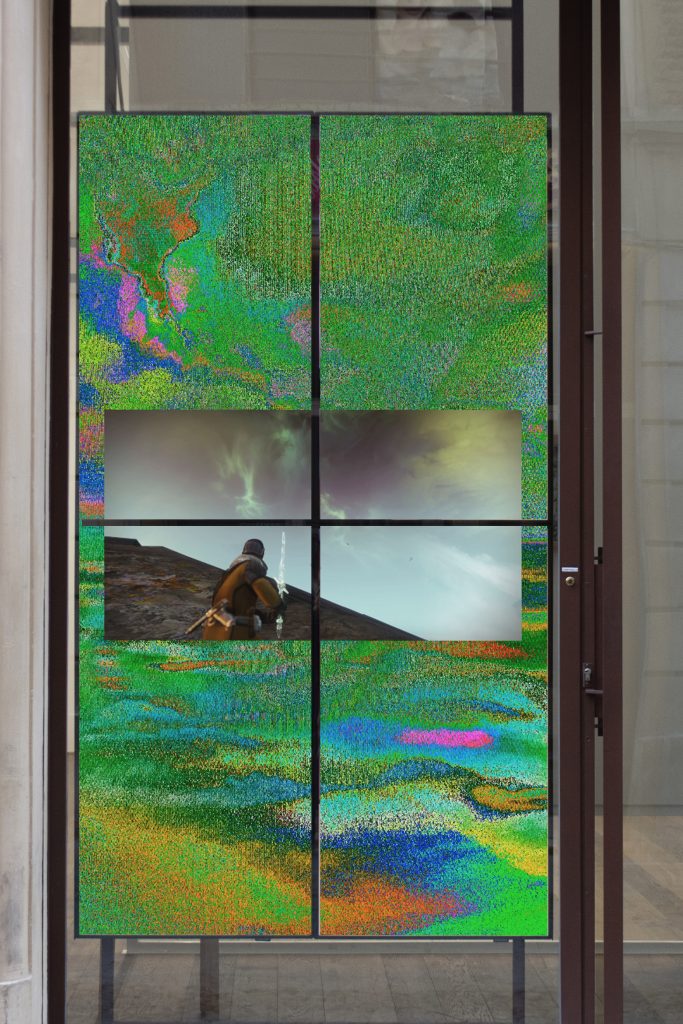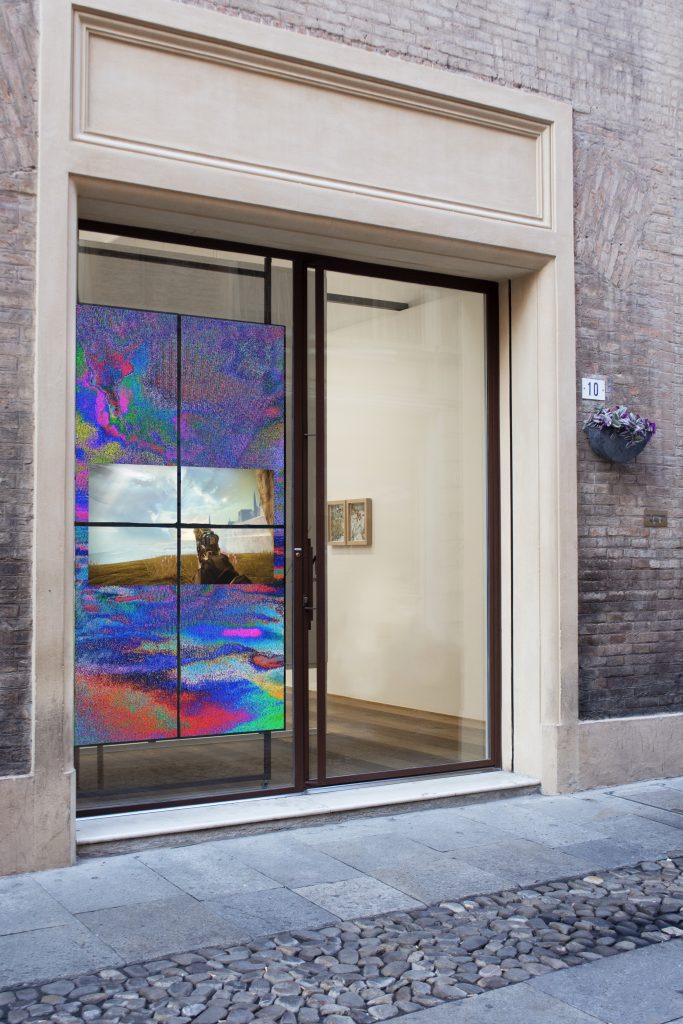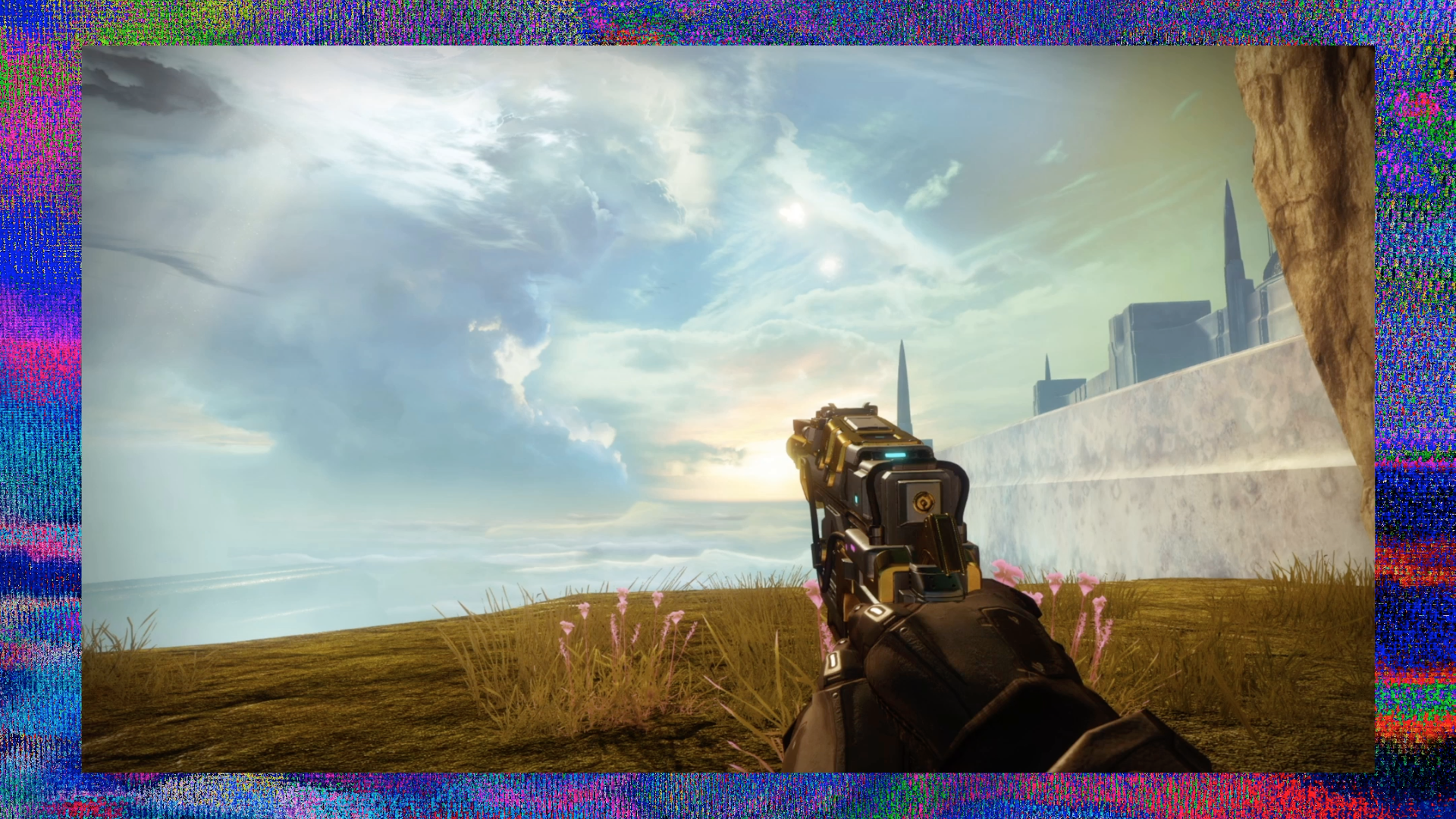Carson Lynn
In occasion of the current exhibition of Storm and Stress by the artist Carson Lynn for the program, curated by Gemma Fantacci, FILTRO, third edition of DIGITAL VIDEO WALL, an annual project promoting the dissemination and experimentation of digital art, Generazione Critica has interviewed the artist.
Generazione Critica: Your artistic practice sits at the intersection between photography and video art and it concerns the subversion of gamespaces and video games’s chauvinist culture. Can you describe your upbringing and how you started incorporating video games into your art?
Carson Lynn: Machinima was actually one of the first creative outlets I had. I was obsessed with Halo 2 when it came out in 2004, and that obsession led me to machinima, specifically Burnie Burns’ Red Vs. Blue and Chris Burke’s This Spartan Life. Eventually, I started to make my own short films and music videos using Halo 3, which then led to creating digital art and graphics on my computer, and then to photography. I pursued photography for my undergraduate degree as I felt it was the most likely medium to lead me to a stable income, but I quickly grew tired of the homogenization in the medium and started to bring in digital art and in-game photography back into my practice.
GC: In previous interviews, you stated to prefer a definition of photography as a light-based medium rather than using the concept of lens-based medium as your approach to images is exactly the same in a virtual world as in a physical one. Can you explain this point of view and its relationship with video games’ systems? What did trigger you in using photography not as a means of representation but as a way to undermine the heteronormative architecture of systems?
CL: I started using the term light-based when I was in undergrad as I felt many artists were being very restrictive with what they deemed to be an actual/genuine photograph, with many photographers declaring phone photography as something below digital and analog photography with a standard camera. A lot of my photography work in undergrad was specifically made to make virtual worlds look real and physical worlds look fake. Photography is often seen as a way to represent reality, and I really enjoy subverting that expectation. Also, modern video games and their aesthetics are greatly influenced by photography and the concept of photorealism, so part of my desire to steer away from conventional photography is also pointing to my desire to have less photorealism in games.
GC: A glitch is usually interpreted as an error or a brief interruption that prevents something from working as it should. At the same time, that same glitch can pinpoint to a specific aesthetic or can represent a getaway to “visualize the unknowable”, as you mentioned during an interview with Chris Priestman for Kill Screen, to queer gamespaces. Can you give us a definition of glitchscape according to your photographic projects?
CL: I think of glitchscapes as being multifaceted. Part of it is the aesthetics: the glitchy, iridescent textures and bizarre formations. The other part is traversal. Landscapes, both physical and virtual, usually have sanctioned and unsanctioned spaces. Desired paths and unexplored areas. To me, the glitchscape is defined by a lack of borders and obstacles. This includes borders on the edges of the gamespace, where the world falls off into nothing.
GC: You mention Galloway’s concept of countergaming as one of the central focuses of your work. He urged the need to exploit the political and cultural vanguard potential of video games in order to unlock their subversive nature as a medium for cultural, social and political observation. It seems that it is the artist’s duty to take action, break the game and introduce this potential, which would therefore seem not to be hidden within the game system itself. Although your work, for example, suggests the opposite. Do you think that the concept of countergaming implies that the artist acts as a deus ex machina on the game, or that it suggests going beyond the standard use and searching for the subtle glitches in the system that can disrupt the status quo? What does it mean to you to subvert a video game’s intended use, to hijack its gameplay?
CL: I know there’s been discussion by others as to whether or not machinima is countergaming or not, but frankly it doesn’t matter too much to me. Subverting a video game’s systems can range from playing wrong to utilizing glitches to heavy modification and anything else in between. The severity or the effort put into the subversion is not important. For me, it’s much more about the intention. What are you trying to say with this performance/glitch/modification? In addition, I think the most interesting work comes from the mixture of these methods of subversion. Modding a game to get a particular aesthetic (like I did in my project I Want) involves both a blend of countergaming and machinima, and this is where I think the most interesting game-related art is coming from: art that defies labels and removes boundaries.
GC: Storm and Stress has different reading levels. It mixes video game culture with Romanticism and the Sturm und Drang movement. Can you delve into this particular relationship and explain why Destiny has been so influential as a video game? Are there any other artistic movements from the past that had an impact on your practice?
CL: All of the footage in Storm and Stress is centered on one particular in-game location in Destiny: The Dreaming City. There’s a high-level activity in this fantasy-themed city, and during a playthrough I stopped to admire the landscape only to have another player call me a homophobic slur for not just playing the game as “intended”. That was the impetus for this project: a desire to investigate why this act was somehow associated with queerness, and if I could extract further queerness from the game by looking longer. That’s how most of my projects start: a loose idea or aesthetic, and then I conduct research in order to further investigate certain elements I want to explore. In particular, I was interested in The Dreaming City’s landscapes and found that they (along with many other Destiny vistas) were largely influenced by Caspar David Friedrich, with the area’s rocky pillars being very informed by Friedrich’s Rocky Landscape in the Elbe Sandstone Mountains (1822). My research then led me to the Sturm und Drang movement, which coincidentally shares the name of my favorite weapons in Destiny: the Sturm hand-cannon and the Drang sidearm. Storm and Stress also felt like such a fitting title: the turbulent storm of toxic masculinity in gaming communities and the stress endured from it.
As for other influential art movements: I’ve always loved paintings from the beginning of the abstract art movement, particularly František Kupka’s Irregular Forms: Creation (1911). The concept of trying to represent the unseeable has been very appealing throughout my artistic career. Even with Storm and Stress I’m trying to find ways to represent queerness with abstraction.

GC: During the interview with Wade Wallerstein on Silicon Valet’s Twitch channel for Storm and Stress’s residency, you said that gamespaces allows people to «craft themselves in an interesting way» and it reminds me of Sarah Levitt’s notion of the avatar as a vessel presenting several version of themselves across a multiplanar mediascape. It’s such a powerful message to encourage people to explore their identity and yet, it seems difficult to really embrace this point of view as we are asked to present the best version of ourselves. Obviously, according to the standard. The contemporary mediascape is saturated with different kinds of norms to abide by, filters to apply, and little room for self expression. Also, mainstream video games’ avatar editors advertise for “freedom of expression” in building your character but this happens in a binary framework. How can we hijack the status quo to create safe queer spaces and not being afraid to speak up? It seems more difficult within the video game culture, even though there are very good games with a wide variety of characters, but I guess that masculinity sells more in the end…
CL: I think a lot of how you are able to represent yourself within digital spaces is controlled by the companies and corporations who create these spaces. Of course, Facebook’s Metaverse is a sterile and commercialized wasteland filled with the most bland avatars imaginable. Second Life and VRChat on the other hand allow near unlimited freedom, and in these spaces is where you see actual freedom of expression. The reason why, though, is because players can create their own avatars from scratch, while most other games allow avatar customization through approved building-blocks on top of approved (and usually binary) canvases. Like I said before, since binary systems are so integral to modern game systems, queerness needs to be incorporated at the core in order to create more safe queer experiences.
However, “hijacking” is a very good term to explain a phenomenon I’ve seen in VRChat, which I wrote about in the latest issue of Heterotopias (http://www.heterotopiaszine.com/008-2/). To summarize, there are many spaces in VRChat that are copies of existing gamespaces from other games, which range from 1:1 recreations to creative reimaginings. This act of remixing virtual environments allows players to be their fully realized avatars in the spaces they aren’t usually allowed to exist in. In addition, modding is also a great tool for hijacking games and making them more queer-friendly. Jake Alaimo’s Pronouns mod (https://www.nexusmods.com/skyrimspecialedition/mods/43816) for Skyrim is one example, but sometimes the binary systems are too integral to the game’s, as selecting they/them pronouns in the mod breaks some quest lines and dialogue options.
GC: I found the statement of one of your recent projects, I Want (2020), to represent very well society’s approach to cultural matters: «A heterocentric game with a rainbow filter is still a heterocentric game: a queer ludic experience needs to be built from the ground up to incorporate queerness at its core». Especially on social media, often we see people adding the rainbow flag on top of their profile image, or sharing it on the stories and posts of their feed because they are reminded that it is the pride week, for example. The problem is that too often this is a temporary virtual message that lasts 24h, like an Instagram story, rather than a concrete action to change the status quo. The same thing happened also during the BLM protests almost two years ago. How do you think we, as a society, can stop just applying the filter and work at the core of things?
CL: Attending protests, forming unions, and donating to causes is honestly the best way to work towards bettering our society, but we live during a time where things only seem legitimate if they are documented, shared, retweeted, and liked. But the filter is not completely useless: without the filter these issues would be overwhelming. Also, these filters can also be a way to learn about issues one may not have exposure to. My art may be closer to a filter than it is to a solution, but if it can lead to someone learning more about queerness and tolerance then it has fulfilled its purpose. The temporary stories and brief trends should be the first step, rather than the entire effort.
GC: The first machinima was created in 1996 and there is an interesting debate about which was really the first one, whether Miracle by Miltos Manetas or Diary of a Camper by United Rangers Films. Over the past 25 years, machinima has changed so much as a medium that it has become something else: it is embedded in and feeds on several artistic languages, from photography to theatrical pieces. How do you think it will evolve in the future? VR is still a less explored field but how do you think machinima and virtual reality could be combined?
CL: On the topic of VR and machinima, I highly recommend WayneRadioTV’s Half-Life VR but the AI is Self-Aware series (https://www.youtube.com/watch?v=vDUYLDtC5Qw): it’s insanely funny and creative, but I think it proves that VR isn’t the next step in machinima, but live performance is. Half-Life VR was created by a group all playing their parts from different corners of the world and then streamed for a huge audience via Twitch. And if I wanted to do something similar, I very easily could: these gamespaces work very well as stages. We’re already seeing this come to fruition in the art world with Kara Güt’s Welcome to my Desert Nexus (https://karagut.info/desertnexus) and I can’t wait to see where the medium of live performance machinima goes next.
GC: Talking about machinima and including in-game photography into the discussion, sometimes there is a bit of skepticism towards game-based artistic practices. However, institutions such as the Fotomuseum Winterthur and the Photographer’s Gallery are doing a remarkable job in researching and presenting artists who work within this field, and several works are presented at important venues like the Berlinale and the Venice Biennale. However, why do you think there is still a stigma towards using video games as an artistic medium and towards game-based research? What could be done further in order to change this perception?
CL: Unfortunately, a lot of this stigma comes from people who still view all video games as nothing more than toys for children, even the mature games: they are something to grow out of. And in my experience it’s very difficult to make them think otherwise. In the context of art, I can normally point to others who have worked with games as an example of the medium’s legitimacy: Harun Farocki, Cory Arcangel, etc. Yet, this normally doesn’t work with those who are unfamiliar with the art world. Honestly, the most success I’ve had is with I Want because of the effect I used to give everything the same color palette and lack of texture and HUD elements. Many people will have an immediate adverse reaction to anything game-related, so removing typical game aesthetics can be an effective method for having game-arts skeptics engage with an artwork.
20/01/2022
Copyrights ©METRONOM


